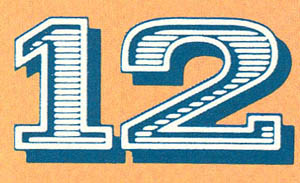Certain numbers seem to appear in almost every book of the Bible, repeated like the refrain of a song. In Pharaoh’s dream in the story of Joseph (Genesis 41:1–7), there are seven fat and sleek cows, seven ugly and thin cows, seven years of grain plump and good, and seven years thin and blighted. In the Book of Numbers, sacrificial offerings and sanctified times are regularly numbered seven (for example, 23:1, 28:11, 28:24, 29:12). Twelve and 40 are similarly popular. Is this repetition simply a coincidence, or are these numbers—known to scholars as “typological numbers”—somehow special?
Philosophers and anthropologists have various theories of the nature and function of numbers. While people of the 20th century generally see numbers as marks on paper, or designs on the screen of a computer—useful devices for keeping track of other real items—many ancient philosophers saw numbers as intermediaries between the sensible world and the world of ideas.1 Numbers may also have symbolic value;2 in other words, they may indicate something other than their face value. What one culture calls a “centipede” (meaning “100 feet”), another may call a “forty-footer,” both indicating by different numbers the fact that the creature has a whole lot of feet.3 In colloquial English, a “billion dollars” rarely represents one cent more than $999,999,999.99.
In the ancient world, numbers were more than just a way of counting. They were sacred clues to the nature of the universe. The writers of the Bible therefore often used numbers to express their own religious ideas. Few of the ancient biblical interpreters were content to treat them only literally. Many believed that numbers, even those in the Bible, could be interpreted allegorically.4
By examining the use of 7, 12 and 40, we can see the range of ways that numbers function in the Bible.

The number seven was sacred in many ancient religions and was generally the prime sacred number. It appears in magic incantations in Egypt, and it had astrological significance in Mesopotamia because it was the number of the “planets” (five visible planets plus the sun and the moon). By the 23rd century B.C.E.,a ritual seven-day festivals combined with the seven-day phases of the moon to produce a religiously sanctioned seven-day week throughout Mesopotamia.
“Seven,” “seventh,” and “seven-fold” appear over 650 times in the Bible and Apocrypha. The first and largest number of occurrences are seven days and years, times of hopeful waiting, such as the seven days Noah waited before seeing if dry land could be found after the Flood (Genesis 8:10–12) and the seven years Jacob served Laban for Rachel (Genesis 29:18 and 20). The Book of Revelation is also full of sevens as times of waiting. Overall, Revelation places the reader at the end of six septets of visions, anticipating the final seventh, when the heavenly Jerusalem will descend to earth.
Many of the seven-day references occur in books written or edited when Israel’s corporate identity was under attack. In those times, the emphasis on seven provided a rallying point for Jewish identity, for it was associated with the observance of the Sabbath, which set Jews apart from their neighbors. Thus one may note the relative frequency of the number in materials ascribed to the Priestly sourceb and the infrequency in materials derived from the period of the Kingdoms—from the time of Saul (11th century B.C.E.) to the Babylonian destruction of the Temple in 586 B.C.E.
Seven was a common number in rituals of the Middle East; it made its way into the lengths of biblical feasts, times of purification, magic and miracles. Samson was tamed when seven locks of his hair were plaited and pinned (Judges 16:13–14). Naaman, the Syrian army commander, had to wash seven times to be cured (2 Kings 5:10). The child of the Shunammite womanc sneezed seven times when revived by Elisha (2 Kings 4:35). Jesus fed 4,000 people with seven loaves (Mark 8:1–10 and parallels). The actual length of rituals and the number of sneezes or loaves were of secondary concern to ancient readers. When they heard “seven,” they did not perceive the numeral for 6 + 1 but instead sensed the power of the divine in the story.

“Twelve” along with “twelfth” appears 247 times in the Bible. This number was likewise popular in the ancient world. Twelve was the product of three times four, so, in a sense, it participated in the sacred power of seven. Unlike seven, it was a convenient factor in Sumerian and Babylonian numerical systems based on the number 60. Mesopotamians developed 12 signs of the zodiac, 12 months, 12 hours of the day and 12 hours of the night. For these people, 12 indicated a felicitous sense of the whole. Among the Greeks, the number of the divinities was complete at 12, and the 12 labors of Heracles were tantamount to all a heroic person could be expected to do. Twelve was a number indicating a full complement, all that is necessary, the human and the divine.
As with seven and seventh, there are several general categories for the use of the number 12 in the Bible. The primary use is for the 12 tribes of Israel, the complete form of the nation.5 Complementing this use is the frequent mention in the Pentateuch (the first five books of the Bible) of natural objects in groups of 12 representing the 12 tribes such as stones, pillars, and springs (for example, Exodus 15:27, 24:4, 28:21, 39:14; Numbers 1:44, 7:87; Deuteronomy 1:23). Because there are 12 tribes and worship is offered on behalf of all of them, discussions of cult often feature sacred objects and sacrifices in twelves (for example 12 golden dishes of incense in Numbers 7:86; see also Numbers 29:17; Ezra 8:24; Ezekiel 40:49).
Twelve thousand, a great multiple represents all Israel. The army of Israel and the whole people are often mentioned as having this number, such as the armies sent against the Midianites (Numbers 31:5) and against Jabesh-gilead (Judges 21:10). Even enemies are reckoned at 12,000 (the people of Ai in Joshua 8:25; compare Ahithopel’s army in 2 Samuel 17:1). Given the Hebrew preference for concrete numbers rather than abstract words,6 such as “many” or “multitudes,” the number should not be taken as an exact enumeration but as an expression of the full complement.
Christian scriptures are also fond of the number 12. Two examples illustrate its distinctive use. First, numbering the apostles at 12 permits them to stand as representatives of the “twelve tribes in the Dispersion” (James 1:1), thus casting Christianity as the “new Israel.” Second, the members of this “new Israel” number not 12,000 total, but 12,000 for each tribe, the 144,000 who are saved in Revelation 7:5–8. This number must be recognized as a literary device to indicate not only the full complement of the saved but also a claim of the Christian supersession of Israel.

There are 120 occurences of “40” or “fortieth” in the Bible. Like seven and 12, 40 was also popular in antiquity. As the product of four times ten, it took on the qualities of stability (represented by four—the legs of a table, the corners of the earth) prolonged and fulfilled (represented by ten, a complete number). It was therefore a number of tense and anxious waiting and of fulfillment. Seven forties was the span of pregnancy’s days. For 40 nights every year the Pleiades, familiar guiding stars, disappeared, provoking wonder and fear.7
In the Bible as well, 40 served as the number of fulfillment. The completion of a full life was 40 years, and old age was considered double 40 (Acts 4:22; Psalm 90:1). After the Flood, the most any mortal could live, even Moses, was three times 40 or 120 (Genesis 6:3; Deuteronomy 34:17).8 The Bible similarly counts 40 years for the reigns of good kings such as David (1 Kings 2:11; 1 Chronicles 29:27), Solomon (2 Chronicles 9:30) and Jehoash (2 Kings 12.1). Although Saul is reputed to have ruled 40 years in Acts 13:21 and in Josephus’ Antiquities of the Jews (6.14.9), the Masoretic text (1 Samuel 13:1) omits his regnal span, perhaps because 40 years would have indicated divine favor, which would have contradicted Saul’s disfavor at the end of the biblical story.9
Forty indicated waiting and anticipation too, as the number of the days of rain in the story of the Deluge (Genesis 7:12, 17, 8:6), and the days Moses spent on the mountain with God (Exodus 24:18, 34:28; Deuteronomy 9:9, 11, 18, 25). In the New Testament, Jesus spent 40 days in the wilderness preparing for his mission (Mark 1:13 and parallels).
Forty is also the number of penitence and expiation. Examples include the 40 years of the wandering of the Jews in the wilderness—a punishment for wanting to return to Egypt after spies bring back their report of a 40-day reconnaissance (Numbers 14:33–34)—and the deadline of 40 days that Jonah gives Nineveh to repent (Jonah 3:4).
In all these uses, the precise count of 40 mattered less than indicating to the audience a good long time, more than a month (30 days) or a generation (30 years). Forty is the number of days in which a person could adapt personal habits, as in the case of Christians who observe Lent for 40 days. It is also a long enough time in years for a grandparent’s vivid memories to become a grandchild’s dim history. The emphasis is not on a specific time but on time enough for change.
A literal interpretation of numbers in the Bible impoverishes it, but a careful comparison of texts allows us to read between the lines, or between the figures, if you will, to experience the richness of the text.
MLA Citation
Footnotes
B.C.E. and C.E. are the scholarly, religiously neutral designations corresponding to B.C. and A.D. They stand for “Before the common Era” and “Common Era.”
If this prophecy could be reinterpreted in this way to refer to later events, phrases like “in the latter days” would be reinterpreted to refer to the “end of days.”
See Mathew Black, “The Strange Visions of Enoch,” BR 03:02.
Endnotes
Y. K. Kim. “Palaeographical Daring of
Bruce Metzger, The Text of the New Testament: Its Transmission, Corruption, and Restoration, 2nd ed. (Oxford: Oxford Univ. Press, 1968), pp. 40–41.
Kurt and Barbara Aland, The Text of the New Testament (Grand Rapids MI: Eerdmans 1987) pp. 101–102; and Metzger, p. 6.

